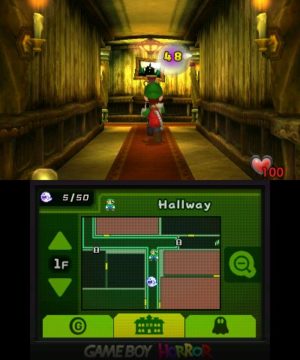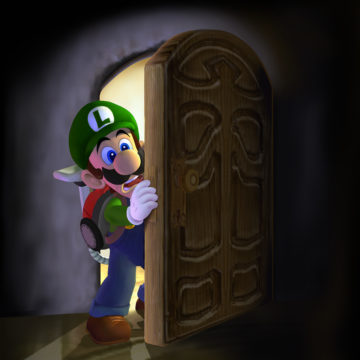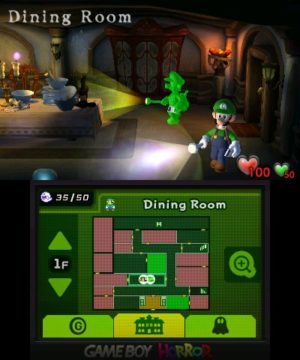Core gameplay of catching ghosts is as brilliant as ever; delightful animations and soundtrack; great visuals; tons of replay value; co-op is well implemented; Amiibo integration is subtle but useful for those who need it
Second control stick is stiff whether using a Circle Pad Pro or a New 2/3DS; game could still benefit from some diversification to its gameplay
We recently looked back at both the original Luigi’s Mansion and its sequel Luigi’s Mansion: Dark Moon, noting both the legacy of these two games as well as what made each of them tick. Dark Moon was certainly not a bad game, but one major takeaway that I had after recently replaying it was that it seemed to miss the point in some ways about what exactly made the first Luigi’s Mansion so special. While we already know that Luigi’s Mansion 3 is coming to Switch at some point, returning to the series’ roots with this remake of Luigi’s Mansion is hopefully a sign that Nintendo knows where Dark Moon went wrong (such as an overly chatty and hand-holding Professor E. Gadd!) and will be looking to balance things out with the upcoming sequel. Luigi’s Mansion remains one of the real gems in all of video games, employing that special brand of Nintendo magic mixed with exceptional play controls to produce an engaging and unforgettable experience.
Released way back in 2001 as the premier launch title for GameCube, Luigi’s Mansion was a technological marvel and showpiece for what Nintendo’s then-newest home console was capable of. Luigi’s Mansion on 3DS (developed by Grezzo, the studio responsible for The Legend of Zelda: Ocarina of Time 3D and Majora’s Mask 3D) is a similarly impressive showcase of the nearly eight year old handheld. Every detail of the original game has been remade from the ground up for this new iteration, seemingly in the same (or a modified version of) engine that Dark Moon was. The results are overall very good, although there’s no getting around the fact that, in certain aspects, the GameCube Luigi’s Mansion is still visually more potent.
Luigi’s Mansion as a series is all about engendering within the player a desire to explore. It’s a hallmark of Nintendo’s design ethos that dates all the way back to The Legend of Zelda on NES. One of the ways that Nintendo was able to accomplish this in Luigi’s Mansion was via the insanely detailed environs of the mansion. The sprawling residence is a labyrinth of halls and rooms stuffed with nooks and crannies to explore. In the original, a big part of what made rooting around the myriad number of rooms in the mansion was how beautiful it all looked. With every step Luigi took, swirls of dust spun to life behind him, with his flashlight cutting through the particulate matter and illuminating the countless bits of furniture and drapery and more that filled every room.
This attention to detail and graphical vibrancy remains on 3DS and is just as compelling as ever, albeit as noted above, the GameCube version is still noticeably better looking than its handheld counterpart… for the most part. Truthfully, the differences are going to really only be noticeable to eagle-eyed fans who played the original, but there are some downgrades to be seen here. There’s less dust kicked up by Luigi’s frightened shuffling, and overall some of the lighting and texture work aren’t as rich. Yet, despite these issues, there are also some notable visual improvements from the GameCube version. Some character models are more detailed, for instance, and the brightening of the mansion makes it easier to get around. The best way to compare the two games is to concede that both look great but for different reasons.

Speaking of improvements, the 3DS take on Luigi’s Mansion also comes with some much appreciated quality of life tweaks. The Game Boy Horror, Luigi’s means of navigating the mansion and investigating the sights within its interior, is now ever present on the bottom touch screen. The map, which was formerly rendered in 3D in the original game, is now depicted in a 2D pixelated style that’s arguably more intuitive to look at and quicker to establish where Luigi is located at any given moment. Some mechanical adjustments have also been incorporated, like the (optional) additions of the Strobulb and gyro controls from Dark Moon. There’s even Amiibo integration, with the Toad, Luigi, Boo, and Mario figurines able to do things like replenish health and make it easier to pinpoint hidden Boos.
One area that Luigi’s Mansion comes up a tad short is its controls. The original game made full use of the GameCube controller, including the stubby, iconic C-Stick for aiming Luigi’s flashlight and the Poltergust 3000. Luigi’s Mansion utilized a dual-control stick setup that was fairly uncommon at the time but which has become standard in countless games today. Unfortunately, whether using the Circle Pad Pro or the C Stick on a New 2/3DS system, neither option works very smoothly in its attempts to replicate the controls of the original. Both inputs are more stiff and jerky than would be preferable, even after messing around with the sensitivity levels in the option menu. An alternative exists in using gyro controls, but I personally hate them and avoid them whenever possible because I don’t find them nearly as accurate or intuitive.

This business with aiming might not be a problem for players who embrace motion controls, but if you’re like me and prefer traditional inputs, Luigi’s Mansion simply isn’t as easy to interact with on 3DS. In fairness, there’s a third option in the form of a control scheme that brings things more in line with Dark Moon (which will be a boon for those who played the sequel but never the original), but that control scheme is, frankly, inferior to the GameCube one and not much of a benefit considering Luigi’s Mansion was never designed with it in mind. This is the biggest issue with Luigi’s Mansion on 3DS, but it doesn’t make the game unplayable. It’s just an annoyance that doesn’t seem to have a real, workable solution at this point.
Grezzo certainly did an admirable job in other regards to breathing new life into Luigi’s Mansion. The original game was actually intended to be playable in 3D once upon a time, a feature that was ultimately dropped but has finally been realized on 3DS. It adds a ton of depth to the mansion and makes it even more engaging to explore, as a result. There’s also a new co-op mode (so long as each player has a copy of the game) that allows two players to make their way through the mansion at the same time. The “how” of it is very interesting, so I won’t spoil it here, but know that busting ghosts as a duo is good fun. There are also in-game achievements, a new S-Rank to achieve, and other extras tucked into this version of Luigi’s Mansion that add a lot of replay value and will be enticing even to those who played the original.

Perhaps the last, major question fans might have about Luigi’s Mansion is whether or not it still holds up all these years later. I’ve already written elsewhere (click those links above!) about playing the game in 2018 versus 2001, but I’ll reiterate here that it’s a formula that has easily withstood the test of time. For those who don’t know, this is a game about Luigi saving Mario for a change. The swap of roles remains a breath of fresh air. What’s more, the gameplay isn’t about running and jumping in large, 3D worlds. Instead, Luigi is confined to the small rooms of the mansion and must use his Poltergust and flashlight to incapacitate the rogue spirits floating about and return them to their eternal rest. Admittedly, a sense of repetition can set in during extended play sessions as Nintendo didn’t do a lot to diversify the gameplay. Outside of some elemental ghosts and light puzzle solving, Luigi’s Mansion sticks to its formula with little deviation.
Which isn’t a bad thing. The game is relatively short, so outside of playing for hours on end, it isn’t likely that players will be turned off by the fun of catching ghosts. It’s imperfect, but Luigi’s Mansion on 3DS remains a wonderful game. The core gameplay has lost none of its luster, and the improvements and additions implemented by Grezzo make the game more entertaining than ever. While the rough nature of the second control stick makes aiming more of a chore than it should be, it’s a defect that largely doesn’t hold Luigi’s Mansion back. It would have been nice to see the visuals more on the level of the GameCube original, but this is still a stunner on 3DS. Don’t sleep on this one, as it’s a perfect way of introducing fans to the series and refreshing longtime ones as they await Luigi’s Mansion 3 on Switch!




 ShareThis
ShareThis





